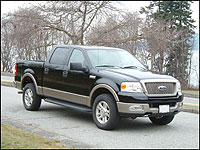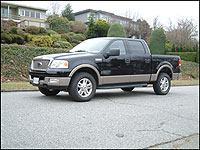2004 Ford F150 4x4 Crew-Cab Lariat
3-21-2004
by
Rob Rothwell
, Canadian Auto Press
|
Although my test vehicle was not so equipped due to late availability, the F150 Supercab and Supercrew models come with an overhead modular rail system that can be customized with snap-in storage and accessory modules, including an optional rear seat DVD system. Expect to see this sort of "customization technology" propagate throughout the truck, SUV and minivan marketplaces. It makes excellent use of, what have historically been acres of wasted roof liner.
 |
| Ford has assembled the F150 with the care and accuracy normally seen in premium cars, not full-size work trucks. (Photo: Rob Rothwell, Canadian Auto Press) |
My close and detailed inspection of the interior and exterior of the F150 Lariat impressed me. This is a truck that has been assembled with the care and accuracy normally associated with premium automobiles not domestic pickup trucks. Body panels and doors, including the tailgate, are fitted together with precise and even gapping. That tailgate, incidentally, boasts a cantilevered design making it especially easy to open and shut. Doors also close with the secure "whump" that imparts a sense of solidity and quality. Interior fit and finish is of luxury car caliber and all controls are conveniently and thoughtfully placed.
 |
| Ford claims the new truck is nine times stiffer than its predecessor, thanks to a strong inflexible chassis. (Photo: Rob Rothwell, Canadian Auto Press) |
The sense of solidity generated upon closing the F150's doors is reflective of the rigidity that permeates the entire vehicle. Such solidity begins with a strong, inflexible chassis (yes there is a time when being inflexible is an attribute, Honey are you reading this). The F150 underpinnings are attached to a frame, which features a hydro-formed front section, fully boxed frame rails and tubular crossmembers. Ford claims that this arrangement is approximately nine times stiffer than the frame supporting its predecessor. It doesn't take a rocket scientist, or a Ford engineer for that matter, to figure out that a torsionally rigid chassis will improve ride comfort and handling dynamics. It will also prevent rattles, squeaks and cowl shudder when bumps or potholes are encountered: definitely a good thing. |
|
|

